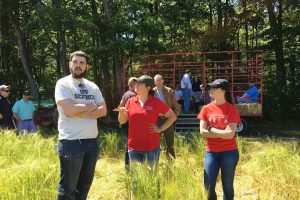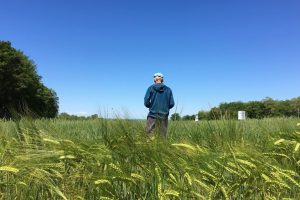-Magdalen Lindeberg

Over 85 growers, government and industry representatives, and Cornell personnel gathered on June 8th at the Musgrave Research Farm in Aurora NY to hear updates on crop development and management practices for small grains including wheat, oats, rye, and barley.
Wheat
Bill Cox reported that nitrogen is a major constraint to growing organic wheat and suggested that added nitrogen is particularly important during the stem elongation phase of wheat development. Gary Bergstrom and Jaime Cummings reported on disease incidence, resistance in different lines, and fungicide trials for Alternaria leaf spot and stripe rust on wheat. David Benscher (Sorrells program) reported on the performance of various wheat lines as well as other small grains.
Malting barley
This crop continues to be a major focus owing to rising demand spurred by the 2013 New York Farm Brewery Law. Malting barley reports focused on disease management (Bergstrom program), economics of production in New York State (John Hanchar), and breeding and performance of various lines (Daniel Sweeney – Sorrells program).
Hybrid Rye
Claus Nymand from KWS Cereals provided an overview of the uses and production of hybrid rye, emphasizing its benefits as food for both hogs and people. Several KWS lines were highlighted by David Benscher for their high performance in hybrid rye trials.
Perennial Grains
Sandra Wayman and Eugene Law from Matthew Ryan’s research program presented information on the perennial rye and Kernza, an improved line of perennial wheatgrass. Perennial grains crops have many ecological advantages and are showing economic potential for niche markets. Ongoing research in the Ryan program is focused on optimizing crop production, ecological benefits, and grower and processor perceptions of production and use.
More information




